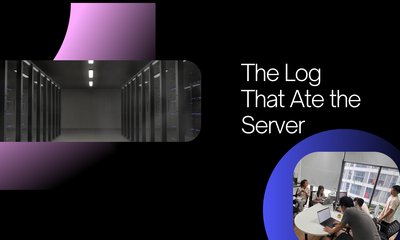The Log That Ate the Server
By khoanc, at: Sept. 20, 2025, 3:20 p.m.
Estimated Reading Time: __READING_TIME__ minutes


Introduction
Logs are meant to be your allies: breadcrumbs for debugging, a record of what went wrong. But when used carelessly, they can overwhelm your system, obscure real issues, or even crash your application.
This is the “Logging Trap”: a situation we at Glinteco encounter often when rescuing clients whose systems are drowning in their own logs. It’s a common, avoidable problem but one that separates teams who just deploy from those who deploy with confidence.
The Scene: Silent Errors, Noisy Logs
A Django application runs flawlessly in development but behaves strangely in production:
-
Critical errors go unnoticed. Buried beneath thousands of meaningless DEBUG lines
-
Disk usage spikes overnight. Log files balloon until they fill up storage
-
CPU usage climbs. The server isn’t serving users; it’s stuck writing logs
At this point, the Logging Trap has sprung and what should be a developer’s best friend becomes their worst enemy.
Even major companies have faced outages caused by poor observability or unchecked logging practices, proving this isn’t just a small startup issue.
How Teams Fall into the Logging Trap
These missteps appear innocent but have costly results:
-
Overly Verbose Logging: Leaving DEBUG logs on in production
-
Unstructured Logs: Plain text dumps with no standard format
-
No Rotation or Retention Policy: Log files that grow forever
-
Reentrant Logging Bugs: Recursive loops triggered by logging inside exception handlers
This isn’t just a technical nuisance, it’s actually a business problem: lost uptime, frustrated users, and wasted developer hours.
According to Gartner, businesses are increasing their observability and log monitoring spend by double digits, showing how costly ignoring these issues can be.
Debugging & Fixing the Trap
Here’s how experienced teams (and what we do at Glinteco) tackle it:
-
Monitor Disk & Volume
-
du -sh /var/log/* and log rate checks catch problems before they explode.
-
-
Set Proper Log Levels
-
DEBUG for dev, INFO/WARN for production
-
-
Implement Structured Logging
-
JSON logs make analysis with ELK/Datadog effortless
-
-
Enable Rotation & Retention
-
Python’s RotatingFileHandler or cloud drains keep logs lean
-
-
Guard Against Reentrancy
-
Avoid recursive logging loops that crash apps
-
-
Centralize Observability
-
Tools like Sentry, Prometheus, or Grafana put you in control.
-
Lesson Learned
Logs should illuminate problems, not cause new ones. The Logging Trap is a reminder to treat logging as part of your architecture, not an afterthought.
At Glinteco, we’ve transformed chaotic, crashing log setups into streamlined observability systems for startups and enterprises across Australia, Japan, the USA, and beyond. Our mission: make sure your developers focus on building features, not chasing log files.
If your app is struggling under the weight of its own logs, let’s talk. We’ll help you turn noisy chaos into clear, actionable insights.





